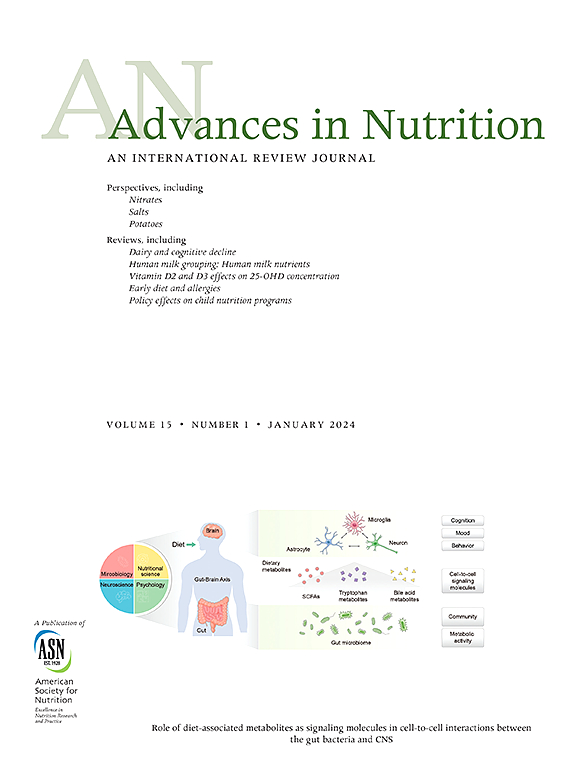Accuracy of Using Weight and Length in Children under 24 mo to Screen for Early Childhood Obesity: A Systematic Review
IF 9.2
1区 医学
Q1 NUTRITION & DIETETICS
引用次数: 0
Abstract
The global increase in early childhood overweight and obesity has prompted interest in early prediction of overweight and obesity to allow timely intervention and prevent lifelong consequences. A systematic review was conducted to assess the accuracy and feasibility of predicting overweight and obesity in individual children aged 3–7 y using data available in healthcare and community settings on children aged under 24 mo. This review was registered in PROSPERO (CRD42024509603) and followed the Preferred Reporting Items for Systematic Reviews and Meta-Analyses guidelines. From 7943 unique articles identified through PubMed, CINAHL, Scopus, and Google Scholar, 14 studies met the inclusion criteria, 13 from high-income countries and 1 from a middle-income country. These studies evaluated the accuracy of predicting childhood overweight or obesity in individual children using anthropometrics-alone or multiple-predictor models. Anthropometrics-alone models yielded areas under the curve (AUCs) ≥ 0.56 with expert guidance and ≥0.77 with machine learning. Multiple-predictor models yielded AUC ≥ 0.68 with expert guidance and ≥0.76 with machine learning. The inclusion of child, parental, and community predictors improved predictive accuracy but led to greater variation in performance across models. Models were more accurate when children were older at the initial assessment, multiple assessments were made, and the time between assessment and outcome prediction was shorter. Prediction models with an AUC ≥ 0.70 used machine learning to optimize variable selection, limiting their practicality for broad-scale implementation in healthcare or community settings. There is insufficient evidence on the accuracy of overweight and obesity prediction models for children in low- and middle-income countries. Existing prediction models are not well-suited for broad-scale screening of individual children for risk of early childhood overweight or obesity.
24个月以下儿童体重和身高筛查早期儿童肥胖的准确性:一项系统评价
全球儿童早期超重和肥胖的增加促使人们对超重和肥胖的早期预测产生兴趣,以便及时干预和预防终身后果。利用卫生保健和社区环境中24个月以下儿童的数据,进行了一项系统评价,以评估预测3至7岁儿童个体超重和肥胖的准确性和可行性。本综述在PROSPERO注册(CRD42024509603),并遵循系统评价和meta分析指南的首选报告项目。从PubMed、CINAHL、Scopus和b谷歌Scholar检索到的7943篇独特文章中,14篇研究符合纳入标准,其中13篇来自高收入国家,1篇来自中等收入国家。这些研究评估了使用人体测量学单独或多重预测模型预测儿童个体超重或肥胖的准确性。单独的人体测量模型在专家指导下的曲线下面积(aus)≥0.56,在机器学习下的aus≥0.77。多重预测模型在专家指导下的AUC≥0.68,在机器学习下的AUC≥0.76。儿童、父母和社区预测因子的纳入提高了预测的准确性,但导致模型之间的性能差异更大。当儿童在初始评估时年龄较大,进行多次评估,评估与结果预测之间的时间较短时,模型更准确。AUC≥0.70的预测模型使用机器学习来优化变量选择,限制了其在医疗保健或社区环境中大规模实施的实用性。关于低收入和中等收入国家儿童超重和肥胖预测模型的准确性,证据不足。现有的预测模型并不适合于对个体儿童进行大规模的早期超重或肥胖风险筛查。
本文章由计算机程序翻译,如有差异,请以英文原文为准。
求助全文
约1分钟内获得全文
求助全文
来源期刊

Advances in Nutrition
医学-营养学
CiteScore
17.40
自引率
2.20%
发文量
117
审稿时长
56 days
期刊介绍:
Advances in Nutrition (AN/Adv Nutr) publishes focused reviews on pivotal findings and recent research across all domains relevant to nutritional scientists and biomedical researchers. This encompasses nutrition-related research spanning biochemical, molecular, and genetic studies using experimental animal models, domestic animals, and human subjects. The journal also emphasizes clinical nutrition, epidemiology and public health, and nutrition education. Review articles concentrate on recent progress rather than broad historical developments.
In addition to review articles, AN includes Perspectives, Letters to the Editor, and supplements. Supplement proposals require pre-approval by the editor before submission. The journal features reports and position papers from the American Society for Nutrition, summaries of major government and foundation reports, and Nutrient Information briefs providing crucial details about dietary requirements, food sources, deficiencies, and other essential nutrient information. All submissions with scientific content undergo peer review by the Editors or their designees prior to acceptance for publication.
 求助内容:
求助内容: 应助结果提醒方式:
应助结果提醒方式:


